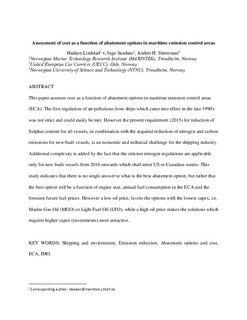| dc.contributor.author | Lindstad, Haakon | |
| dc.contributor.author | Sandaas, Inge | |
| dc.contributor.author | Strømman, Anders Hammer | |
| dc.date.accessioned | 2017-11-07T09:32:45Z | |
| dc.date.available | 2017-11-07T09:32:45Z | |
| dc.date.created | 2015-07-21T14:18:25Z | |
| dc.date.issued | 2015 | |
| dc.identifier.citation | Transportation Research Part D: Transport and Environment. 2015, 38 41-48. | nb_NO |
| dc.identifier.issn | 1361-9209 | |
| dc.identifier.uri | http://hdl.handle.net/11250/2464505 | |
| dc.description.abstract | This paper assesses cost as a function of abatement options in maritime emission control areas (ECA). The first regulation of air pollutions from ships which came into effect in the late 1990s was not strict and could easily be met. However the present requirement (2015) for reduction of Sulfur content for all vessels, in combination with the required reduction of nitrogen and carbon emissions for new-built vessels, is an economic and technical challenge for the shipping industry. Additional complexity is added by the fact that the strictest nitrogen regulations are applicable only for new-built vessels from 2016 onwards which shall enter US or Canadian waters. This study indicates that there is no single answer to what is the best abatement option, but rather that the best option will be a function of engine size, annual fuel consumption in the ECA and the foreseen future fuel prices. However a low oil price, favors the options with the lowest capex, i.e. Marine Gas Oil (MGO) or Light Fuel Oil (LFO), while a high oil price makes the solutions which requires higher capex (investments) more attractive. | nb_NO |
| dc.language.iso | eng | nb_NO |
| dc.publisher | Elsevier | nb_NO |
| dc.rights | Attribution-NonCommercial-NoDerivatives 4.0 Internasjonal | * |
| dc.rights.uri | http://creativecommons.org/licenses/by-nc-nd/4.0/deed.no | * |
| dc.title | Assessment of cost as a function of abatement options in maritime emission control areas | nb_NO |
| dc.type | Journal article | nb_NO |
| dc.type | Peer reviewed | nb_NO |
| dc.description.version | acceptedVersion | nb_NO |
| dc.source.pagenumber | 41-48 | nb_NO |
| dc.source.volume | 38 | nb_NO |
| dc.source.journal | Transportation Research Part D: Transport and Environment | nb_NO |
| dc.identifier.doi | 10.1016/j.trd.2015.04.018 | |
| dc.identifier.cristin | 1254703 | |
| dc.relation.project | Norges forskningsråd: 237917 | nb_NO |
| dc.description.localcode | © 2015. This is the authors’ accepted and refereed manuscript to the article. This manuscript version is made available under the CC-BY-NC-ND 4.0 license http://creativecommons.org/licenses/by-nc-nd/4.0/ | nb_NO |
| cristin.unitcode | 194,64,25,0 | |
| cristin.unitname | Institutt for energi- og prosessteknikk | |
| cristin.ispublished | true | |
| cristin.fulltext | postprint | |
| cristin.qualitycode | 2 | |

